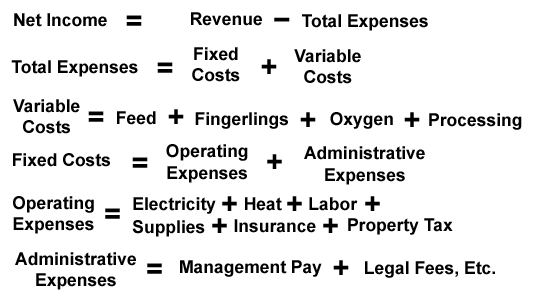

People are attracted to recirculation aquaculture as a way of earning an income. While it is possible to make money in recirculation aquaculture, it is difficult. Agriculture is not an easy or reliable way to make money and recirculation is a difficult form of agriculture. It is possible to master the biology and engineering presented in this course and successfully produce fish (though this "easy" part presents its own pitfalls), but selling them for a profit is another matter. The recirculation aquaculturist has many competitors including wild caught fish and cultured fish produced by extensive (ponds and raceways) means. There are domestic and foreign suppliers of both wild caught and extensively cultured fish.
One of the best species for recirculation aquaculture, tilapia, is also grown in large numbers in ponds in tropical regions. These can be produced and processed very cheaply, so that even with shipping costs, the wholesale price in the U.S. is low. The recirculation aquaculturists are most often successful when they target a niche market, such as selling live fish as mentioned in the previous chapter. A model of success that recirculation aquaculturists might pursue has been used by the farmers of pond raised channel catfish. They have essentially established a brand "Farm Raised Catfish" based on quality. Because all Farm Raised Catfish have been tested for off flavor, the consumer is assured of a good tasting fish, an assurance they don't have when buying wild caught or imported, cultured fish.
 |
 |
In an earlier chapter, the need for an engineering study of system design before investing large sums of money was discussed. Likewise, a business plan should be completed before beginning a for-profit operation and will be required before any loans can be made. While a full scale economic analysis is beyond the scope of this chapter, the basics will be discussed.
A profit and loss statement projects profits and losses into the future. This is based on predicted revenues (sales of fish) balanced by predicted expenses. Expenses are broken out into variable costs and fixed costs. Variable costs are dependent on the amount of production, the cost of feed is a good example. As production increases, the variable costs will go up proportionally. Fixed costs, on the other hand, remain largely the same within a range of production. It is here that savings of scale are realized. If you double production the variable costs will double, but the fixed costs remain the same, so each fish is produced more cheaply. Fixed costs are further broken down into operating expenses (power bill, etc.) and administrative expenses. Revenue minus total expenses equals net income. There are still some expenses to account for before the owner can pocket the net income, however. Net income doesn't include interest paid, income taxes, or depreciation. Depreciation takes into account the fact that even durable goods do not last forever. It has tax consequences (depreciation can be deducted from income), but also real world consequences (equipment does wear out and needs to be replaced). Tax depreciation and real world depreciation can be different. Depreciation is the cost of ownership per year and is calculated by subtracting any salvage value from the original value and dividing by the years of service. For tax purposes, years of service range from 7 years for light equipment to 20 years for commercial buildings.
Bank loans for recirculation aquaculture are difficult to acquire, even with a thorough business plan. Most operators begin by investing heavily from their own resources and those of family and friends.